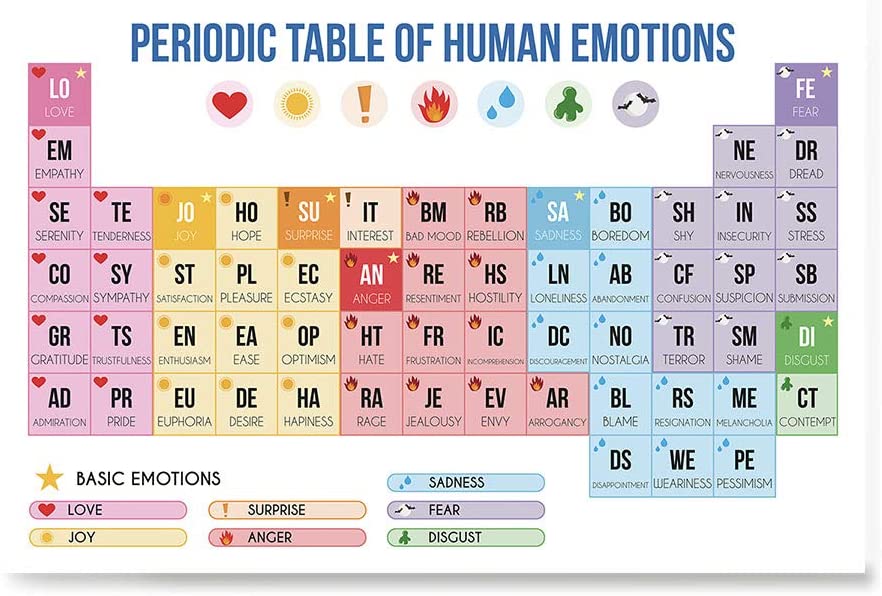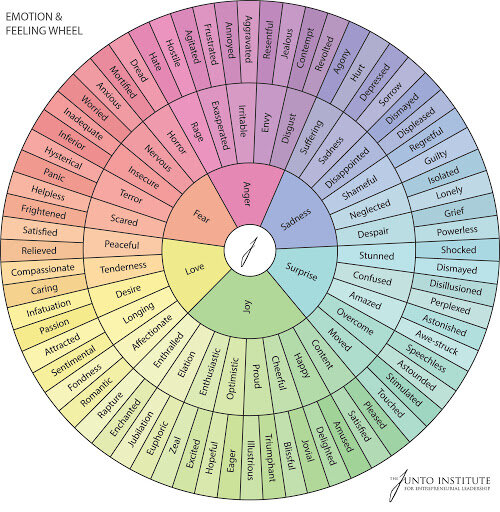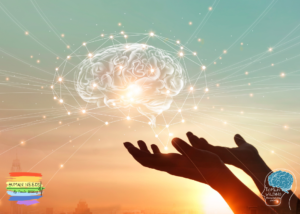What do emotions do?
Understanding emotions is a key aspect of understanding emotional regulation, which is essential to meeting human needs. Emotions serve as a messaging system in our nervous system. They provide a feedback loop that helps us to meet our needs and to learn how to better meet our needs in the future. When someone’s needs are not being met, they feel emotions. Emotions are signals to let us know to do something about meeting our needs. Emotions work to do three things: elicit motivation, provide energy to act, and cause us to reflect and remember. They tell us how to act in the pursuit of meeting our needs, and they contribute to activating other systems in the brain and body when necessary. All the emotions, are necessary, and have a specific purpose.
Emotions are largely experienced in the amygdala, and from there, take one or more of three paths:
- Emotion motivates behaviour to meet a need (drive)
- Emotion activates threat system in the brain stem (survive)
- Emotion is regulated by the frontal cortex (soothe)
Understanding emotions at the core
Our core emotions have an important set of purposes. Each one has its own purpose, however, they all function to:
- Tell us that we have an unmet need
- Motivate us to act to meet the need
- Instruct the body to provide energy (hormones, etc.,) to act
- Cause us to reflect on our needs and responses
- Create or strengthens neural pathways to select response for next time.
In very simple terms, understanding emotions means understanding the messages they are sending us. It is easiest to begin with the core emotions, from which all other emotions are derived through being mixed with other emotions, and our cognition (thinking). There is some argument as to which are the core basic emotions. However, there is much agreement that a number of core emotions exist from which all other more complex emotions are derived. If you have seen the Disney Pixar film “Inside Out” you may have some idea of these. If you haven’t seen it, it’s worth a watch. The psychologists who worked on that film chose just five core emotions to keep it simple for children, However, they recognised that there are few others. Similarly, whilst acknowledging diversity of opinion, through exploration of the research, we have selected the following as eight core emotions:

Anger
That is wrong.
Resist and change.
Anger is a core emotion, the purpose of which is to signal that something is wrong; and thereby to motivate us to rectify this.
In order to work with anger, figure out what’s wrong, and how to change it or make it stop. If the situation involves another person, it is usually most effective to seek understanding yourself, or with a different person. Subsequently, having regulated your own emotions, you may choose to discuss it with them, to find a solution; on the other hand you may choose to walk away from them.

Surprise
That was unexpected.
Retreat and assess.
Surprise or shock is a core emotion, the purpose of which is to make us quickly retreat because we don’t know what we’re dealing with. It motivates a fast reaction to back off consequently providing us with time to assess the situation. Subsequently, now better informed we can determine our response.
To work with surprise and shock, recognise the feeling, and take the appropriate time to make a measured assessment. For instance, after a difficult emotional experience, considering precisely what triggered shock. This is helpful in order to understanding your feelings, expectations and the situation more reflectively.

Joy
That was good.
Do it again
Joy is a core emotion, the purpose of which is to signify that our needs are being met by this experience. Consequently, we are motivated to repeat this.
To work with joy, notice when you feel joy and what you are doing. Consider what need is being met; as a result you can determine whether this is the best way to meet that need. Subsequently you can choose whether to repeat this behaviour, or find another way to meet that need.

Disgust
That might be poisonous.
Avoid it.
Disgust is a core emotion, the purpose of which is to alert you to things that may endanger you by poison or contagion. Consequently it motivates caution, and therefore, often avoidance. This caution relates not only to things that can physically endanger you; but to also things that might emotionally, sensorily, or socially poison you.
To work with disgust, notice what it occurs in response to; subsequently you can assess whether it will really poison you; and make conscious choices about whether there are benefits that outweigh this. For example, taboos socially condition disgust responses to different behaviour. Engaging in, or engaging with those who engage in, these behaviours, can damage your social standing. However, through this engagement you may break down harmful stigma about harmless behaviour; consider gender norms and sexuality.

Guilt
You did this wrong.
Fix this.
Guilt is a core emotion, the purpose of which is to inform us that we have acted outside of our own, or our community’s values. Consequently it motivates us to act to rectify any damage that we have caused to our relationships, or to our community.
To work with guilt, notice what you feel you have done that has triggered the emotion, and assess whether the feeling is valid, or whether you are being overly harsh with yourself. If you have acted outside of your values, you can now seek to rebalance and repair your relationships.

Sadness
Something is gone.
Rest and reflect.
Sadness is a core emotion, the purpose of which is to inform us that we have lost something that helped us meet our needs. Consequently, sadness motivates us to slow down, rest, actively remember and reflect, thereby enabling us to process our loss.
In order to work with sadness, we need to identify the loss we have experienced; determine whether there are any elements that can be retrieved; and subsequently get support to adjust to meeting our needs without that which we have lost.

Fear
Danger!
Protect yourself.
Fear is a core emotion, the purpose of which is to tell us something is putting us in danger; and consequently to motivate us to protect ourselves at all costs. This emotion is the most primal survival instinct and will likely result in one of the threat responses.
Working with fear can be tricky. Controlling your reaction to fear and threat is usually not possible, certainly in the short term. However, in the long term it may be possible to change your fear triggers if your triggers do not actually threaten your safety. Additionally, it may be possible to alter which threat response occurs. Everyone will have a “go to” threat response for specific situations. Understanding these responses and your personal triggers is helpful in working with fear.

Love
This connection is good.
Keep this close.
Love is a core emotion, the purpose of which is to tell us that a relationship is meeting our needs. In particular, meeting our needs for connection, but potentially many other needs too. Consequently, it motivates us to maintain the relationship and keep the loved person close to us.
Working with love is a little like working with joy. Be mindful and conscious of when love arises; subsequently use reflection to decide whether maintaining specific relationships is meeting your needs in a long-term healthy way. Recognising our love emotion and working hard on those relationships that do meet our needs is essential.
More complex emotions
As mentioned at the start, these core emotions form the basis for related and more complex emotions. Here are two depictions of how this complexity can be viewed. There are many more examples on the internet. Visuals, such as these, can be helpful in looking at how our emotions relate to each other.








